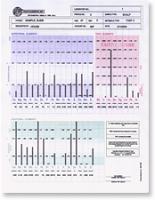Calcium To Magnesium Ratio in Hair Testing
Order a Hair Tissue Mineral Analysis – Hair Test Here
Copper toxicity is related to stress and initially affects the calcium level. If the calcium to magnesium ratio is very imbalanced, greater than 15:1 or less than 2.5:1, then emotional stress is present and should also be addressed in lifestyle. Stress of any kind can affect the calcium to magnesium ratio.Emotional stress, even if positive can affect the calcium to magnesium ratio.
Calcium To Magnesium (Ca/Mg) Ratios
- 12 to 16 – Diabetes
- 10+ AND a potassium level below 5 is hypoglycemia
- 6.67 to 10 – Good
- 6.67 IDEAL
- 5 to 6.67 – Good
- 3.3 to 5 – Dysinsululism
- 2-3.3 – Diabetes
- Greater than 16 to 1 as the calcium to magnesium ratio or a very low calcium to magnesium ratio less than 2.1 is frequently associated with mental or emotional disturbances.
Cortisone therapy or lower calcium levels. Cortisone therapy will raise sodium and potassium levels. Lead and cadmium toxicity will displace calcium.
Double Inversion – Low Calcium to Magnesium Ration and Low Sodium to Potassium Ratio
If a double inversion is present or adrenal exhaustion is suspected, the first priority for correction is the sodium to potassium ratio. As this improves, often the calcium to magnesium ratio will then improve as well. The two ratios may alternate in their improvement over a period of months.
A deficiency of magnesium relative to calcium (a high Ca/Mg ratio) may allow calcium to precipitate out of solution, which can contribute to calcium deposition into the urinary tract and gallbladder. Over an extended period of time, magnesium deficiency and high calcium has been correlated with increased tendencies toward kidney and gallstones.
Normal Calcium To Magnesium Ratio
- Calcium and sodium are extracellular elements and magnesium and potassium are intracellular element.
An Calcium To Magnesium Ideal Ratio:
The ideal Ca/Mg ratio in of hair is about 6.67/1.
- Calcium In Tissues: Magnesium is required to keep calcium in solution. When the calcium magnesium ratio is imbalanced, it may reflect a relative magnesium deficiency. Ratios greater than 10/1 or less than 3/1 indicate a tendency for calcium to be held in the tissues. This can cause bone spurs, arthritic changes, arterial calcification and calcium stone formation in the kidneys or gall bladder.
- Carbohydrate Issues: Generally, a Ca/Mg ratio lower than 4/5 or greater than 8/5 is indicative of a sensitivity to sugars and simple carbohydrates.
- Hypoglycemic: Between 10/1 and 12/1, or 3/1 and 3.3/1 are considered hypoglycemic ranges.
- Severe Sugar/Carbohydrate Issues: Over 12/1 and less than 3/1 are considered a severe sugar and simple carbohydrate sensitivity range.
- Calcium In Tissues: Ratios greater than 10:1 or less than 3:1 also indicate a tendency for calcium precipitation in the tissues. This can cause bone spurs, arthritic changes, arterial calcification and calcium stone formation in the kidneys or gall bladder. Magnesium is required to keep calcium in solution. When the ratio is imbalanced, it may reflect a relative magnesium deficiency.
Abnormal Calcium To Magnesium Ratio
- Highly Imbalanced Ratios: above 12:1 and less than 3:1 will often indicate emotional difficulties.
- An imbalanced Ca/Mg ratio usually indicates excessive carbohydrates in the diet. Carbohydrate-rich foods are grains, pasta, bread, potatoes, beans, carrots, peas, corn, fruit, sweets and sugars honey and maple syrup, etc.
- Most people are not aware or truthful about the amount of carbohydrates they consume. Carbohydrates are hidden in prepared and packaged foods. Many foods have added sugar fructose and other sugar.
Stress and The Calcium To Magnesium Ratio
- Sodium and magnesium are antagonistic and so is calcium and potassium.
- Stress of any kind can affect the Ca/Mg ratio. Severe stress will inhibit or override any dietary or supplement program.If the Ca/Mg ratio is very imbalanced – greater than 15/1 or less than 2.5/1 – emotional stress must be addressed.
- Adrenal glands and stress: Stress effects the adrenal glands and glucose metabolism. Stress can increase blood sugar via cortisol, leading to reduced sugar tolerance. Cortisol release increases osteoblastic activity that may lead to a higher tissue calcium level as calcium is released from the bones.
- Excessive calcium channel activity from stress can cause a catabolic state, with increased cell death and release of magnesium from the cells.
- An imbalanced Ca/Mg ratio may be secondary to an imbalanced Na/K ratio which is known as the blood sugar ratio and effects of energy production.
- Sodium and magnesium are antagonistic, as are calcium and potassium.
- When both Ca/Mg and Na/K ratios are low, it is referred to as a double inversion. It can reflect a more severe Na/K inversion, associated not only with carbohydrate intolerance, but also immune system weakness, protein catabolism, chronic emotional stress and adrenal exhaustion.
- If Ca/Mg and the Na/K ratios are elevated, the high Ca/Mg ratio may reflect a more severe high Na/K pattern, associated with acute stress, inflammation and related symptom.
Correcting Imbalances In Calcium to Magnesium RATIOS
- Carbohydrates: Reducing dietary carbohydrates, improving digestion and correcting the diet in accordance with the oxidation type. Supplementing with sufficient zinc, magnesium, vitamin B6 and taurine are helpful, along with the other nutritional supplements as indicated by other hair analysis patterns.
- Stress: Reducing stress may be very important. Severe stress can inhibit or even override any dietary or supplement program! Any time the Ca/Mg ratio is very imbalanced – greater than 15:1 or less than 2.5:1 – emotional stress is likely and important to address.


